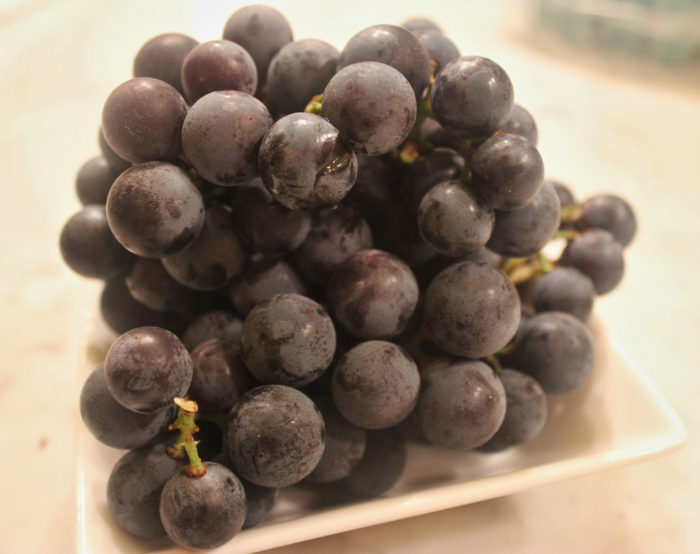
The season for Concord grapes is almost over, lasting just from the end of August to mid-October. Then you have to wait a full year. Act now.
There is no other flavor like Concord. Which explains the juices and the jams. There are other ways to employ Concord grapes, though you may not have tried them. This particular recipe comes from the CIA, a trusted source, and you need trust here because there is some effort involved. The seeds in Concord grapes are the issue. And the skins provide a challenge. So, the steps here involve getting the pulp from the skins. And the seeds from the pulp. You’ll be cleaning your strainer twice, or more.
For one pie recipe, I saw a suggestion of serving this pie with peanut butter ice cream. Slices of Wonder Bread would be optional. [Think about it: grapes, peanut butter, sandwiches.]
Sorry. Get your grapes and get your strainer.
Ah, not only is this the season for Concord but also for the faux Concord grapes. There are Mars, Mercury and Cotton Candy varieties out there — though in New York the candy has yet to arrive. Suzi and I prefer Mars. You may, too. Seedless and very similar to a Concord but sweeter. Now, as you know, sweeter is better.
This recipe assumes you have a double-crust pie dough ready to go. This pie recipe comes from CIA Pies and Tarts, which has lots and lots of pie shell ideas but which, sadly, is out of print. If you are lucky, you have a copy. Otherwise, you’ll need to talk to your grandmother. Or consult Ken Haedrich’s delightful Pies.
Concord Grape Pie from the CIA
Yield: serves 8-10
Ingredients:
- 8-10 cups Concord grapes, rinsed and stemmed
- 3 tablespoon cornstarch
- 1 cup granulated sugar
- 1 teaspoon fresh lemon juice
- Egg was
- Granulate sugar as needed
Preparation:
Preheat the oven to 375°F and set the rack in the lowest position.
Roll out half the dough and prep a 9-inch pie plate.
Extract the pulp from each grape by pressing the end opposite the stem end, reserving the grape skins in a small bowl. Place the pulp in a wire-mesh strainer set over a medium bowl. Allow the pulp to drain for about 39 minutes. Reserve ¼ cup of the liquid and discard the rest [or save for cocktails!].
In a medium saucepan, cook the pulp over medium heat, stirring frequently with a whisk, until the seeds start to separate from the pulp, 8 to 10 minutes. Place a wire-mesh strainer over the bowl with the grape skins and strain the cooked pulp into the bowl, pressing on the solids in the strainer with the back of a spatula. Discard the seeds and set aside the grape pulp and skin mixture to cool to room temperature, about 30 minutes.
Strain the cooled mixture into a medium bowl. Combine the cornstarch and the reserved liquid. To the cooled pulp mixture, add the cornstarch mixture, sugar, and lemon juice. Pour the mixture into the prepared bottom crust.
Roll out the dough for the top curst to ⅛ inch thick. Transfer the top crust to the filled pie, carefully setting it over the filling. Trim the edges of the top crust flush with the edge of the bottom crust and press to seal. Turn and decorative crimp the edges. Using paring knife, cut vents into the cop crust. Brush the top crust with egg wash and sprinkle liberally with granulated sugar.
Place the pie on a rimmed baking sheet. Bake until the filling bubbly and thick, 45 to 50 minutes. Remove the pie from oven and place it on a cooling rack. Let cool for 2 to 3 hours. The filling will continue to thicken and set as the pie cools.
Source: CIA Pies and Tarts
Photo Information: Canon T2i, EFS 60mm Macro Lens, F/3.5 for 1/30th second at ISO‑1250
